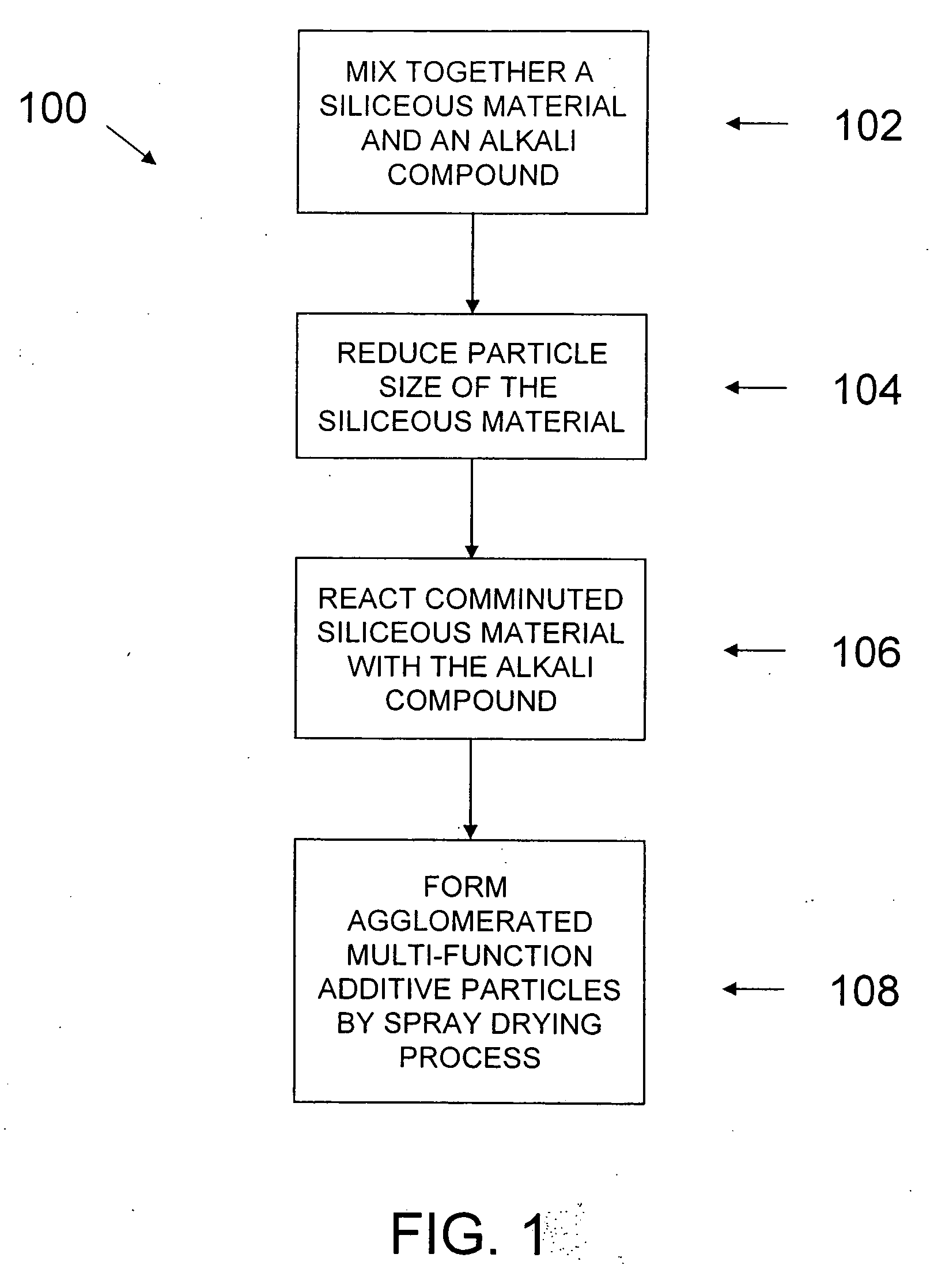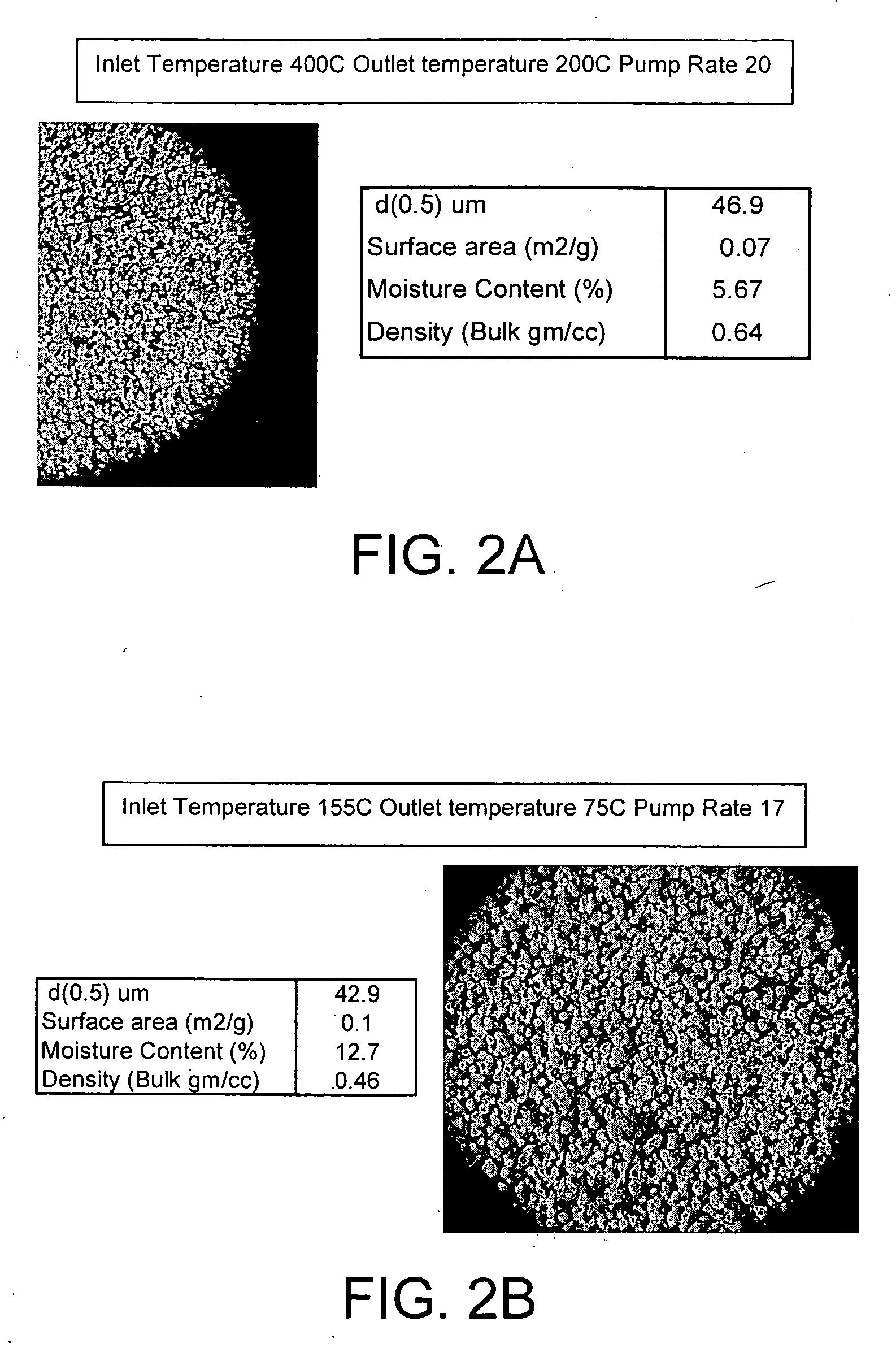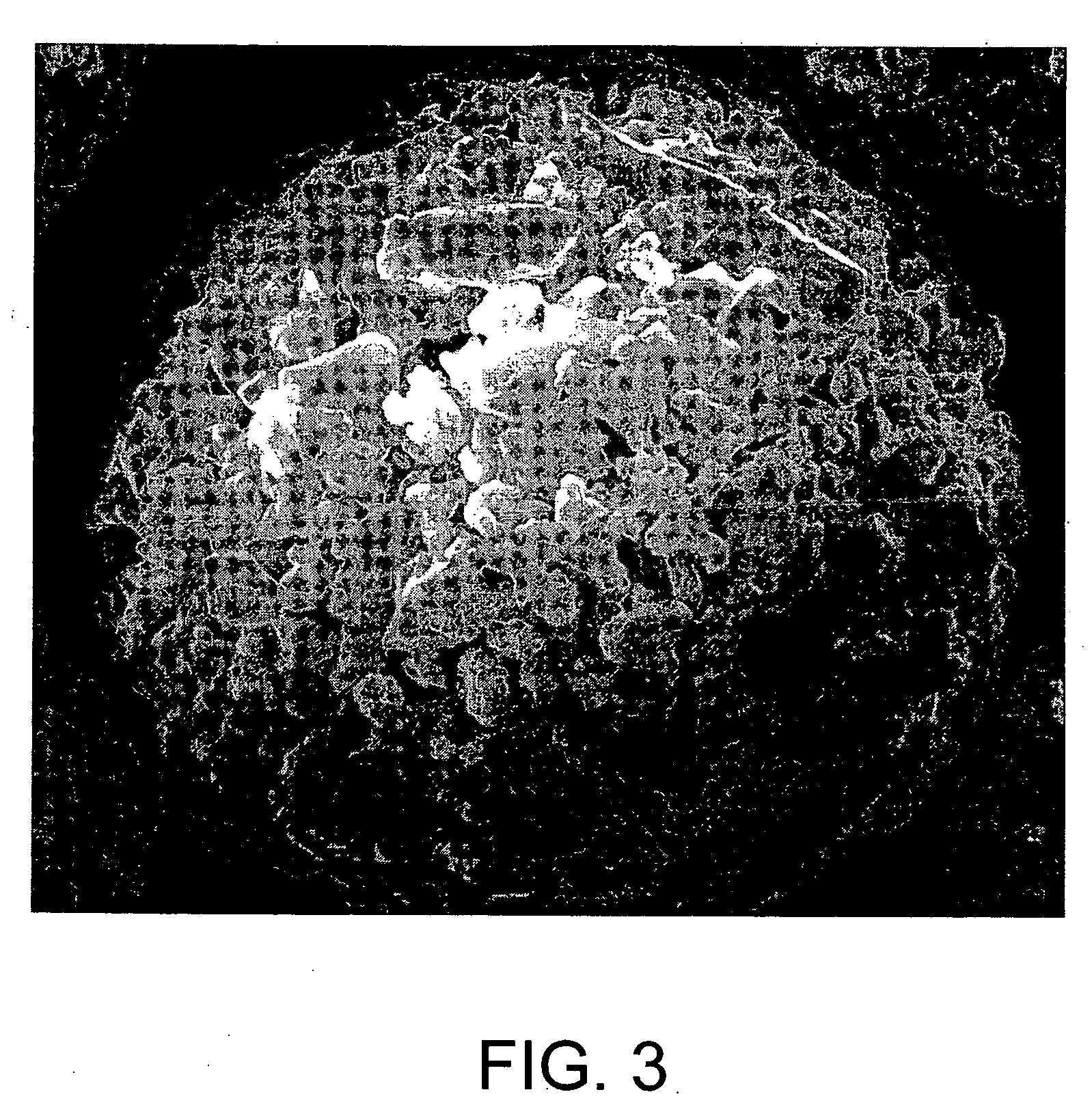[0013] In one aspect, the preferred embodiments of the present invention provide a multi-function additive composition for a settable
composite material. The composition comprises an
alkaline activation compound and a plurality of modified siliceous particles or aggregates, wherein each modified siliceous particle has a first region that is morphologically altered by a chemical. Each of the modified siliceous particle also has a second region that is not morphologically altered by the chemical. Preferably, the first region comprises about 0.1% to 95% of the volume of the particle, more preferably about 0.5% to 80%, more preferably about 2% to 50%, and more preferably 4% to 30%. In one embodiment, the first region of the modified siliceous particle is gel-like, porous, spiky or edgy. In another embodiment, the first region comprises a part of the exterior surface of the particle and the second region comprises primarily a core of the particle. In other embodiment, the first region is also chemically altered by the chemical. The alkaline activation compound is preferably selected from the group consisting of alkali
silicate and silica enriched alkali silicate, such as
sodium silicate,
potassium silicate, and
lithium silicate or combination thereof. In certain implementations, the composition can be incorporated in a cementitious formulation, a fiber
cement building product,
gypsum composite or a
polymeric matrix. In some embodiments, the additive composition preferably enables acceleration in setting and hardening of the settable composite material. In other embodiments, the additive enables hardening of the settable composite material in non-elevated temperature and / or pressure conditions.
[0016] In yet another aspect, the preferred embodiments of the present invention provide a method of forming a multi-function additive for settable composite materials. The method comprises the steps of (a) providing at least a siliceous material and at least an alkali compound, (b) reducing the particle size of the siliceous material, and (c) reacting the siliceous material with the alkali compound in a manner so as to form a mixture comprising alkali silicate and a plurality of modified low density siliceous particles wherein each particle has at least a first portion that is morphologically and / or chemically altered by the alkali compound and at least a second portion that is not morphologically and / or chemically altered by the alkali compound. Preferably, the one or more altered regions on each particle comprise about 0.1%-95% of the volume of the particle. Preferably, at least one region of the siliceous material remains unaltered from the original material. The alkali compound is preferably selected from the group consisting of
alkali metal hydroxides,
alkaline earth metal hydroxides, weak-acid
alkali metal salts, alkaline silicates and combinations thereof. In one embodiment, the method further comprises adding the multi-function additive to a settable composite material composition to accelerate the rate of setting and hardening and reduce the density of the composite material. Preferably, the composite material includes
aluminosilicate and a
calcium-bearing cementitious material such as
Portland cement, aluminous
cement,
fly ash,
blast furnace slag,
cement kiln dust which can further contribute to setting and hardening of the composite material.
[0019] In yet another aspect, the preferred embodiments of the present invention provide a method of accelerating the hardening of a settable composite material comprising
aluminosilicate and modifying the density of the material. The method comprises (a) providing a mixture comprising water glass and a plurality of low density siliceous particles having one or more regions that are altered by an alkali compound, (b) adding the mixture to the composite material composition, and (c) reacting the mixture with the
aluminosilicate in the composite material composition. In one embodiment, the composite material composition comprises a binder selected from the group consisting of
Portland cement, water glass, and combinations thereof. In another embodiment, the mixture increases the rate of hardening of the composite material by about 5%-100,000% as compared to an equivalent composite material without the mixture. In yet another embodiment, the mixture enables the composite material to harden without being substantially subjected to a hydrothermal condition and / or without the need of being subjected to a hydrothermal condition. In yet another embodiment, the mixture lowers the density of the composite material by about 0.1%-50% as compared to an equivalent composite material without the mixture.
[0020] In yet another aspect, the preferred embodiments of the present invention provide a settable composite material comprising a binder, an aluminosilicate material, and a multi-function additive comprising alkali silicate and a plurality of modified low density siliceous particles having a first region that is morphologically and / or chemically altered by a chemical and each of the modified low density siliceous particles also have a second region that is not morphologically and / or chemically modified by the chemical. Preferably, the additive reacts with the aluminosilicate to increase the rate of hardening of the composite material and wherein the low density siliceous particles lower the density of the composite material. In one embodiment, the composite material is a
cementitious composite material, preferably fiber reinforced
cementitious composite material such as a fiber cement panel, a fiber cement
pipe, or a fiber cement cladding board. In one embodiment, the binder in the composite material comprises water glass. Preferably, the multi-function additive increases the rate of hardening of the composite material by about 5%-1000% as compared to an equivalent composite material without the multi-fiction additive. In yet another embodiment, the mixture enables the composite material to harden without the need of being subjected to a hydrothermal condition. In another embodiment, the composite material further comprises un-altered low density additive. Preferably, the multi-fiction additive lowers the density of the composite material by about 0.1%-50% as compared to an equivalent composite material without the multi-function additive.
 Login to View More
Login to View More 


